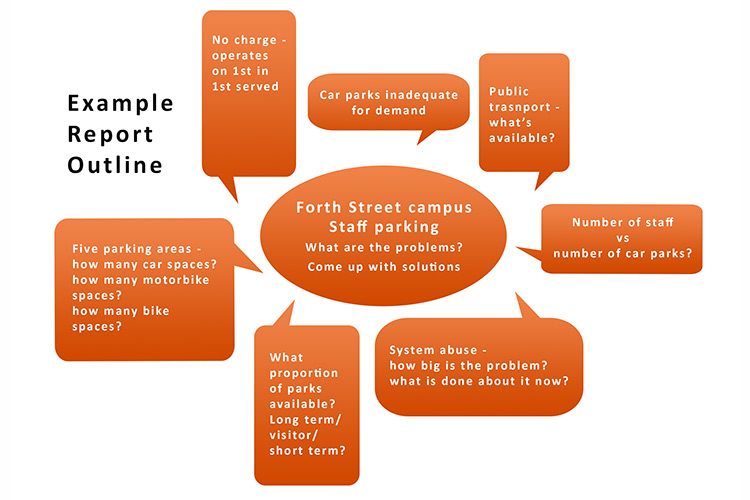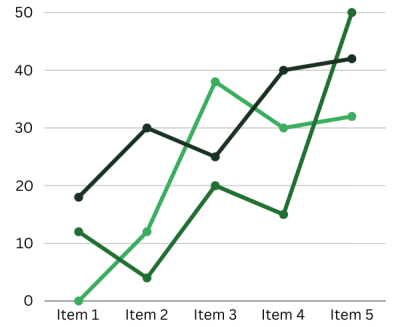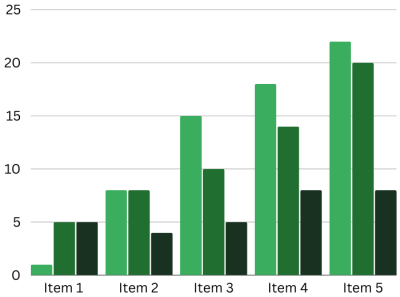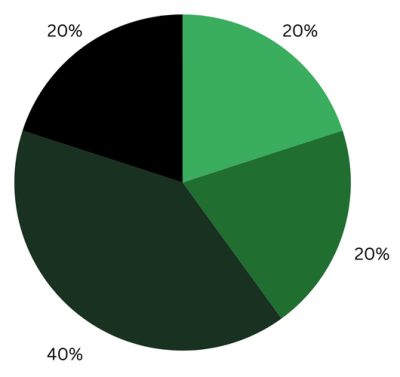Business reports
A business report conveys information to assist in decision-making. The report is the means to present this gathered information. This page will show you how to gather and evaluate information effectively to write a business report.
Topic
An example topic has been chosen to illustrate the process of writing a business report. A sample marking criteria is also avaliable.
Example topic
Aim: To write effective business reports applying professional standards.
Tasks: Produce a short formal report, including conclusions and recommendations, to a professional standard using currently recognised formats for content and referencing. Produce a letter of transmittal using accepted professional standards for layout, structure and tone.
Instructions: There are major parking concerns for staff on campus at Otago Polytechnic. On the one hand, there are not enough car parks for all staff; on the other hand, the management team knows that staff are very touchy on the subject since the majority consider access to a parking space a 'right' rather than a 'privilege'. There are five parking areas at the Forth Street Campus.
Currently parking is offered free of charge to staff on a 'first in, first served' basis. Staff who have not parked before 8.20 a.m. are not likely to find a space in the staff parks, and must compete with students and the public to find parking on the street. There are also problems with non-staff cars being parked illegally in the staff parks.
The polytechnic management team wishes to find solutions to these problems which are agreeable to all staff, as well as being financially viable. They are not willing to significantly reduce existing areas of lawn and garden.
Write a short analytical report examining the issues and making recommendations to the management team about ways to resolve the parking issues.
The Findings section of your report should be approximately 1000 words. The letter of transmittal should be approximately one page. Your report should include all the following sections, each of which should begin on a new page:
-
Title page
-
Letter of transmittal
-
Table of contents
-
Terms of reference
-
Executive summary
-
Procedure
-
Findings
-
Conclusions
-
Recommendations
-
Reference List
-
Appendices (optional)
Define and plan
Where to start?
Business reports do not necessarily need to follow a standard format as long as they are well organized, but there are a few key steps that should be made before writing business reports. These are:
- Defining the task
- Defining the scope of the report
- Determining your audience and
- Researching sources
Define the task
What is the purpose of business reports?
Business reports are commonly used to help people make decisions. They provide comprehensive information and expert opinion that aims to be objective, accurate and complete. Examples of decisions are:
- Deciding whether or not to open new export markets
- Questioning whether government broadcasting regulations on censorhip are adequate
- Whether or not to invest in a company based on their annual business reports
Research is a critical element of business reports. Therefore, it is important that the research is thorough and accurate. Information that is incorrect or incomplete could lead the audience to draw the wrong conclusion and make faulty decisions.
In general, business reports have one of two purposes:
- To answer questions: these are written with the intention of covering a problem and determining whether or not it is worthwhile to pursue a solution
- To define a solution to a problem: written with the intention of defining a solution or plan of action for a pre-existing problem
Define the scope
One of the first steps to writing business reports is to define the scope of the report. In this step you need to think about the purpose of the report and decide what information needs to be covered. You may want to begin your preliminary outline to guide you when doing the research for your report. At this stage you may also want to write an introductory paragraph to define the purpose of the report.
You need to ask yourself some questions:
- What is report about? What is it not about? You don't need to write a detailed scope at this stage, just an outline structure, showing sections, headings, points and sub-points
- This scope and outline will help shape your research, your writing, and your time frame. How long have you got? What research needs to be done? Make sure you give yourself plenty of time
Define the audience
The next step in writing business reports is to determine the audience for the report. Are you writing it for the general public or a small group of internal employees? Knowing who your audience is will influence how your report is written and what type of information you include.
Consider the audience's:
- Need for the report
- Education level
- Position in the company and
- Knowledge base on the intended topic
If the report is to be written for the general public, it should not include technical terms, nor information that may be commercially sensitive. However, if the business report is written for internal use, it is appropriate to include technical terms and, depending on the position in the company of the audience, it may or may not include proprietary information (material and information relating to or associated with a company's products, business, or activities).
Example business report topic activity
Check your understanding of the definition of the task, scope and audience for the example report topic.
Activity
Plan outline
Outlining is another name for making 'planning notes'.
-
However you plan your report, the aim is to produce a plan that is detailed enough to enable you to take control of your writing, yet flexible enough to allow you to make changes where necessary. Always regard your plan as rough rather than a straitjacket. Be prepared to be flexible as new information comes to hand
-
Identify particular headings and subheadings and list the ideas associated with each. Group related ideas where possible and then arrange them in a logical order
-
You can use an outlining system to organise your ideas. This is also known as a schematic model

| Research areas | Key issues: Current situation |
| Survey staff for opinions on problems | Not enough parks |
| Monitor car aprk usage (make a timetable for this) | Numbers of cars/parks/staff |
| Observe car park layout re: possible alterations (map, DCC aerial images, observations) | Abuse of system (illegal parking) |
| Check public transport options | Demand and Possible solutions to cope with this |
Research sources
You need to decide: do you need primary and/or secondary information? Secondary may be too general, or too out of date, or it may be fine. It all depends on what you need for your research.
Primary sources
Primary sources of information include anything that is original such as:
-
Original research
-
Reports of an event recorded by someone who was there
-
Personal memoirs, diaries and autobiographies
-
Interviews
-
Statistics
-
Photographs
Example: Interview material generated from conversations you have had with various staff members at the Polytechnic is primary source material.
Secondary sources
Secondary information sources interpret, analyse or describe primary sources and events – they are at least ‘one step away’ from the actual event. Many books and articles contain secondary information, including text books and scholarly reviews.
Example: Books and articles written on, for example, employment law or workplace relations in New Zealand would count as secondary sources of information.
Evaluate and select sources

Analyse sources
Once you have selected and evaluated the sources you are going to use, you need to consider in more detail how they will inform the scope and argument of your report. In other words, you need to analyse your sources in more detail.
- Does the material support your argument well?
- Or does the material contradict your argument?
- If you have any statistics or data, what aspects of your argument do they relate to, and do they help illustrate a point?
Redefine scope and revisit outline
Once primary and secondary sources are gathered and studied, it may well be that the scope or focus of the report changes. You may realise your original scope is too broad, or that it is too general. Perhaps what you thought were promising areas turn out to be dead ends or some data may be unavailable.
Redefining the scope is normal, and nothing to get upset about. It may also entail redefinition of your outline, tasks and scheduling.
Now return to your initial outline:
-
Do you need to make any changes to your scope?
-
Do you need to find any more resources to add to your resources list?
-
Do you need to alter or add to your argument in any way?
Have a look at the example plan (outline) you saw earlier. It has been added to and modified.
| Draft order of ideas outline for example topic: Findings |
|
Current situation • Outline current situation: what is available (numbers of parks and their allocation) Car park rules • Historical background (always been free, resistance to introduction of fees) • Overview of issues arising (demand, frustration, illegal parking) |
|
Demand • State average number of staff who drive everyday • Compare staff numbers to car park spaces • Show results of car park usage survey • Issues arising (demand on street, staff lateness, frustration, dangerous parking) • Staff views |
|
Illegal parking • The rules and how they are enforced • Numbers from the survey parking illegally • Issues arising |
|
Layout • Best possible layout of parking spaces? |
Construct
How to structure the report
Most formal, analytical or investigative reports have a standard type of structure, although some individuals and organisations prefer variations upon this structure. They typically have three main sections:
Report structure
• Title page – include the title, name of author, name of person who commissioned the report, date when it was commissioned.
• Contents page - all sections and sub-sections are listed, with page numbers.
• List of illustrations – this may only be necessary if the report is over 5 pages and there are a significant number of graphics.
• Summary/abstract/synopsis - this provides a quick version of the entire report and includes information from the introduction, discussion, conclusions, and recommendations. This is the last part of the front matter.
• Introduction – this is a combination of the terms of reference and the procedures. It includes:
• Why the report was commissioned and why it was needed.
• The purpose of the report.
• The scope of the report and what is covered.
• Definitions of terms (if there are more than 5 or 6, consider a glossary in the end matter.)
• Findings - these are factual and are what you discovered during your research.
• They include an explanation of how the data was obtained.
• They are arranged in logical order.
• Headings are used where possible.
• Conclusions – they are the writer’s interpretation of the facts.
• There may be one or many conclusions.
• They explain what the problem is.
• They summarise the information in the body of the report.
• The conclusions section should contain no new material.
• Recommendations – They are the justified opinions of the writer of what is to be done, who is to do it, and how it is to be done.
• They are set out in numbered paragraphs.
• They should flow on from conclusion.
• The section may include options, alternatives, or responses.
• The recommendations section should contain no new material.
• Appendices - these include material that you want to include, but which is too large to include in the body of the report because it breaks up the flow.
• Such material might be raw data, copies of questionnaires used, interview transcripts, maps, or complex graphics.
• It might be material that is of interest to some, but not all readers.
• If there is more than one, each one should be numbered or lettered (A,B,C or I,II,III)
Letter of transmittal
In many organisations it is common to attach a letter or memorandum of transmittal to the report. If the report is going from one person to another in the same organisation, a memorandum is written. If the report is going to someone in another organisation, a letter is written. It is the most direct message from the writer to the reader.
-
A letter of transmittal should contain...
-
A salutation to the person who commissioned the report
Dear Mr/Ms Jones
-
Statement of purpose of the memo or letter
Here is the report on …that you requested.
-
Brief summary of the report
In this report you will find …
-
Acknowledgements to people who assisted with the report
A number of people were very helpful in preparing this report…
-
A courteous close
Thank you for the opportunity to investigate
I welcome any question you might have about the report.
Tip
Recommendations might also be included in the memo/letter of transmittal, although the author may choose to leave them out if they are appear at first sight to be controversial.
Sample letter of transmittal
|
P.O. Box 90999
DUNEDIN
19 March 2006 Phil Ker Chief Executive Otago Polytechnic Forth Street DUNEDIN Dear Mr Ker, Please find attached the report on Otago Polytechnic staff car parking that you requested on the 20 February 2006. I have detailed the current parking situation and have made some comparisons with the parking systems of other organisations.I have also included staff opinions of the parking situation. My main recommendation is that the parking should stay as it is, with the understanding that staff are encouraged to share transport whenever possible. I also recommend that security barriers with swipe card access be installed to reduce illegal parking. Please do not hesitate to contact me if you have any queries about this report. Yours faithfully |
Add graphic elements
Design graphics
The business report is a structured response to a series of questions posed about an actual or hypothetical business situation. It is intended to convey as much information as possible and address the issues raised in a comprehensive way. To help you achieve a complete response there are many structural tools that can help. These include the use of:
- Headings
- Columns
- Diagrams or sketches
- Margins
- Statistics
- Graphics and charts
- Industry or business specific terminology
- References to case study
Whilst the use of any or all of these structures and presentation devices can help it is important that they are utilised appropriately and well.
Tables
When there is a lot of data that needs to be presented or grouped in a logical way, tables are ideal. Tables are also useful if you need to present actual numbers rather than trends. It is often better to include large tables as appendices rather than in the body of the report. There are some conventions for producing tables in a business report:
- Vertical rather than horizontal orientation. This means you should order dependent variables vertically
- Tables should have a number (1,2 3...etc) and a caption. The caption should be normal case not title case
- Do not separate columns with vertical lines
- Use horizontal lines only to separate headings from data and any footnotes
- Always place a table after your reference to it in the main text and make sure you provide the table number and caption in the main text so that readers can refer to it easily
Graphs
Types of graphs
Used to indicate the relationship between two variables and often used to show trends over time or some other continuous variable like temperature. For example, to show the change in pressure of a gas in a closed system as temperature increases.

Scatterplots perform a very similar function in that they allow us to visualise the relationship between 2 variables, but in this case both variables may be discrete rather than continuous. For example the number of taxa found at different locations along the water of the Leith.

Bar graphs are useful for illustrating frequency or magnitude data, especially when comparisons are required. For example showing the average monthly rainfall for two different years, say 1990 and 2000.

Usually used to indicate relative proportions. For example the relative sizes of sheep, cattle, deer and pig populations in NZ in a given year.

Illustrations
Illustrations such as drawings or photographs should be relevant to the purpose of your report and enhance the value of it.
Such as:
- When trying to add meaning to the findings
- When you wish to improve the presentation of the report
- When you need a visual aid to clarify findings
- Provide a number and caption for your illustration
- Place the figure after the text where you refer to it and provide the figure number and caption
- If the photograph or drawing is not yours make sure that you acknowledge its source and that you have permission to use it
Digital and online media
If you wish to do this, remember to include:
- Make sure that the material on your website is either yours or that you have obtained permission to use it and have attributed sources appropriately
- Double check that the website address or URL is written correctly in your report
- Make sure you provide login details if these are required
- If you are providing links to animations, movies or other files which require the use of a plug-in or other specialised software make sure you provide clear instructions for how to obtain and use the software and note any specific computer or operating system requirements
Produce
The first draft
Using the structure outlined above write the first draft of your report. Remember, what you write at this stage will not necessarily be what the readers see. Very few of us can write a flawless first draft! You should expect to do at least a second draft.
It is good to allow time between drafts. If you get too close, you will tend to lose perspective on your report.
Editing the draft
Once you have produced a first draft you need to edit it. Editing involves checking the content of your writing.
The four key areas to think about while editing
- Go back and make sure you have understood the topic clearly.
- Check to see that you have included all of the information you were asked to.
- Study the marking schedule, and find in your work aspects of the topic you are going to be marked on.
- Re-read your writing and check that all of the content is relevant to the topic.
- Check that you have explained the reasons for your ideas.
- Make sure that you have supported your ideas with the relevant ideas from other authors.
- If you are expressing an opinion, check to see that you have given good reasons why the reader should accept you opinion.
- Read your work carefully to check that your ideas are expressed clearly.
- Look for any sentences that are longer than 20 words and think about shortening them if they are unclear.
- Use short sentences for impact and longer sentences for explanation.
- Check that you have used words linking words appropriately, such as therefore, however, lastly.
- Read each paragraph carefully. Does it contain; a statement; an explanation; perhaps a citation?
- Make sure the paragraphs or sections are in logical order.
- Ensure that the transition from one paragraph to the next is clear.
An example first draft is below. Revisions and corrections have been marked on the draft by the author.

Proof reading
Some of the techniques used to help you get some distance from your writing are:
- Reading the text backwards (starting with the last word in your writing and working backwards to the first word)
- Having someone read the text to you while you check it (making sure that everything, including punctuation, is read out)
- Having someone else read the text
- Placing a piece of card under each line as you read it
- Placing your finger on each word as you read it aloud
Proof reading links

It is also a very good idea to become aware of the sort of errors you make in your writing and keep a record of them in your personal proof-reading checklist.
Citing and referencing
Citing or referencing information provides the reader of your business report with the following details:
- Who wrote the information you have used (ideas, quotations)
- Where the information is located (in a book, newspaper article, report)
When you cite information it is important to present this information consistently. You must acknowledge the sources of your information (who was responsible) because when you don't cite your sources, you may be accused of plagiarism.
Report check list
Final checklist
- Includes a title
- Attractive and durable
- Opening greeting (salutation)
- Statement of purpose of letter
- Brief summary of report
- Acknowledgements
- Courteous close
- Accurate description of the scope and contents
- Same as on the cover page
- Reflects structure of report
- Reflects pagination
- Reflects sequence
- Accurate summary of body and end matter
- Background given
- Purpose described
- Scope defined
- Research methods described
- Terms defined
- Logical development of argument
- Factual approach (no opinions yet)
- Based on materials in findings section
- Based upon material in findings and conclusion
- Complete record
- Accurate use of citation system
- Complete and well set out
- Complete and well set out
- Clear and consistent structure
- Accurate headings
- Grammatically parallel headings
- Adequate white space
- Minimal variation and consistent use of fonts
- Appropriate
- Identified and referred to in the text
- Correctly gathered
- Correctly displayed
- Correct and consistent referencing
- Legitimate
Attributions
Charts SVG Example 13 - Exploded Pie Chart.svg. Wikimedia commons. Licensed under a Creative Commons Attribution-Share Alike 3.0 Unported
Business report. Information Literacy e-Learning Modules. Online Information Literacy. Collaborative project between the University of Otago, Dunedin College of Education and Otago Polytechnic.
Hero image: Aerial crops by Tom Fisk. Licensed under a Pexels.com license



